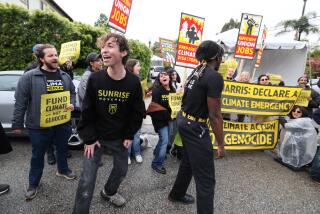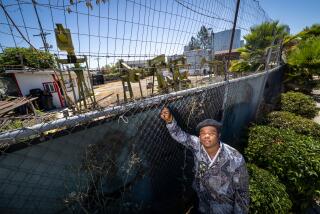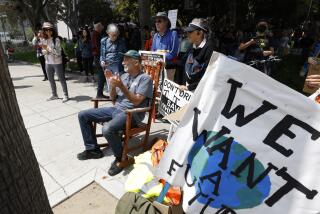Easter on the Road With Peace March: A Renewal of Spirit
AFTON CANYON, Calif. — Where’s the ham?
For the handful of Orange County participants who, along with 300 other marchers, spent Easter Sunday trekking 19 miles across the Mojave Desert on the Great Peace March, the traditional holiday fare was little more than a memory of years past.
Bemused at the thought of how different this day was compared with last Easter, when she sat with in-laws around the family ham dinner, an exhausted and hungry Sue Daniels of Fullerton said, “This has been one of the best Easters of my life.”
As she spoke, Daniels, 46, lay flat on her back with her eyes closed at the dusty campsite off Power Line Road where she and the other marchers had pitched their tents by mid-afternoon. The day’s hike from Yermo, a small desert community, to Afton Canyon--a stretch of lifeless and stark beauty--had brought the cross-county marchers and their message of global nuclear disarmament one day closer to their ultimate goal, Washington.
For Patti Dornan, a 45-year-old mother from Irvine, finding a banana, grape juice and a sweet potato at lunch came close to being a religious experience.
“I blessed my food and gave thanks,” said Dornan, who added that her husband, Ed, and two teen-age sons are rooting for her to go the distance from home.
The holiday spirit was strong at the campsite, despite the surroundings and the separation from friends and family.
Marchers awoke at 4:30 a.m. to a glorious sunrise, a cassette playing Easter music and someone hollering “Hallelujah!” At lunchtime, an Easter bonnet contest was held, with an extra sandwich going to the winner. And children painted and hid Easter eggs at the campsite.
‘Killing Is the Worst’
Ten-year-old Wren Levy of Miami was one of the few people still on her feet as she held out painted, hard-boiled eggs to her fellow marchers.
“I hid all the eggs and then everybody was too tired to find them, so we’re giving them away,” she explained. Then she showed off the egg she painted with blue lettering: “Killing is the worst thing, I think.”
For others, like Dan Nielson of Garden Grove, Sunday’s hike on Power Line Road toward Las Vegas was like “walking in the longest Easter parade” he had ever been in. And for Allan Affeldt, a 27-year-old UC Irvine graduate student who took a leave of absence to go on the march, walking was a perfect way to spend Easter Sunday.
“We got to spend it in a more spiritual and solitary way . . . ,” said Affeldt, as he reclined on a duffel bag. “Walking is sort of a prayer in itself.”
Enjoying a Desert Breeze
By 4 p.m., the campsite was filled with a rainbow of bubble tents and the quiet chatter of a day winding down. Friends offered each other foot and back rubs under a milky white sky, while one of the march’s leaders passed out ice cubes to his thirsty companions. Others put cream on their sunburned faces and lay back to enjoy the warm desert breeze. In the distance, a baby cried.
The remaining marchers said they are determined to push on, even though Sunday was only the second day of walking since the march was halted for two weeks in Barstow. The march, which began in Los Angeles on March 1 with 1,400 walkers, was sidetracked when the original sponsoring organization collapsed for lack of money.
Pointing to the giant power lines that straddled both sides of the dusty road they traveled on Sunday, Patti Dornan, said: “I was all the way at the back of the group today, and walking down Power Line Road I said to myself, ‘This is really symbolic.’ These power lines are means of communication. And I thought, ‘What are we? Lines of communication.’ ”
More to Read
Sign up for Essential California
The most important California stories and recommendations in your inbox every morning.
You may occasionally receive promotional content from the Los Angeles Times.









